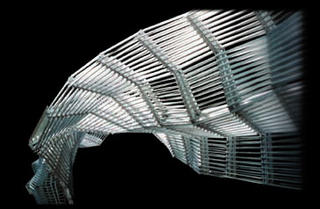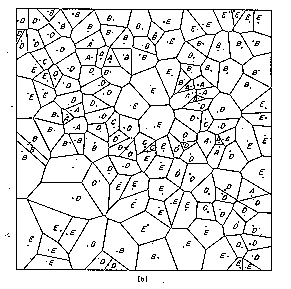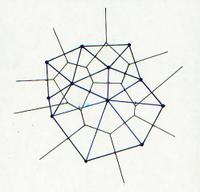
congratulations to my good friends jesse Rodriguez(Jesus) and Alexis flores for winning 3rd place in the urban reserve student design competition in dfw...kickin chickin!!!
in thesis news: will braham from upenn-teaches the m arch 2 kids and has been our curriculum advisor at upenn, has set us--the 7 thesis kids from tulane--up with some professor that has advised many different thesis and phd doctorate candidates in architecture, urban design, and landscape design....he still hasn't revealed the name yet but i'll keep you posted...the guy is currently in paris and will be back in town within the next 2 weeks, so some progress is being made with the thesis set-up.....the situation though is that we have a paper due to asu by october 25th....
in rahim's class we had a guest speaker: mark goulthorpe from dECOI--currently teaches at MIT and is in the process of developing a new computer program
here is one of his projects called ether...here is an exert of his discussion on the project:
Ether/I was made to commemorate the 50th anniversary of the United Nations in Geneva. It is part of a series of sculpted projects (Glass Vessel, Ledoux) where "image/surface/object are ambiguous in their status". Ether/I offered an opportunity to experiment with new techniques of creative formal production. It was the negative trace of two dancers in space that was captured by the vide - the trace that cannot be seen by the naked eye, the necessary difference or error or performance. Ether/I embodies a transitional phase from one state to another, "the trace of an absent presence", a surface which is also depth. If dance is an "architecture of disappearance" (H. Gilpin), Ether/I, which is a tribute to the choreographer William Forsythe, goes beyond the reference to the breakdown of the body into graphs, as in the work of Muybridge. Ether/I is developed like a rambling line of aluminium, interweaving its mesh over a length of more than twenty metres, as if a video were reinstating the ghostlike traces of movements. Ether/I thus embodies a threshold, an energetic phase. For dECOI, the issue of representation is taken to a point of liquefaction..

his presentation in class was very interesting because he was dealing with computational theory...as in complex mathmatical emergent systems created in various programs[catia, rhino,etc.] where the fascination that comes from the form of the final iteration stems from the various fabrication processes required to realize the digital form of the architecture.
the investigation of the idea of elegance in architecture is the purpose of the class, but as discussed in the class, elegance is such a loaded word to describe architecture, and seems to invoke images of an over-programmed, and insufficient modernity...but for this class he is discussing the elegance not in aesthetics but the elegance of the process that produces the architecture that we are investigating....in dECOI's instance, the elegance of the computation and it's iterative results. this class [as in today's presentation] was so interesting, and deals directly with my thesis of emergent and dynamical systems...mark goulthorpe kept talking about a vorronoi...some mathematical principle that i can't even pretend to understand.

A tessellation of a plane is the filling of the plane with repetitions of figures (or polygons) in such a way that no figures overlap and there are no gaps. The number of sides, n, comprising these polygons is 3 <>tessellation is the tessellation obtained by connecting the centers of the polygons in the original tessellation that share a common side or boundary. For example the dual of a tessellation of equilateral triangles is a tessellation of regular hexagons.
Given a set of two or more but a finite number of distinct points in the Euclidean plane, all locations in that space are associated with the closest member(s) of the point set with respect to the Euclidean distance. The result is a tessellation of the plane into a set of regions associated with the members of the point set which is called a planar ordinary Voronoi diagram. The regions are called ordinary Voronoi polygons.
my only worry, should i try to learn maya[in rahim's studio they are learning maya as a tool to set up dynamical systems within modern and post-modern houses--they had a list of around 5-6 houses to choose from]?? i'm thinking that i probably should mess with it at least a little bit because when it comes down to next semester with the building and 3d modeling of my project, i am discussing using this process for the theoretical basis of the project, but if i don't employ these same techniques in the design it would all have been in vain. the problem is that i don't know ANYTHING about maya and even the kids in his studio have basically had to teach themselves with what little help his teaching assistant gives[basically rahim doesn't know maya AT ALL and has had to bring in a swedish tech assistant to help the students with the carrying out of the design skills of dynamical systems that rahim crits them on...wow.] i REALLY wish i had signed up for his studio now...but then i would be losing ALL of my sanity with all the other classes i'm taking. maybe i'll have some time over some holidays...thanksgiving, fall break, christmas, when i'm bored...i'd just be completely lost without ANY type of guidance from the other tulane students that ARE in rahim's studio....i'll have to see what i can do..
for more info on
ps...song of the day: feeling the top 40 hits: kelly clarkson, breakaway

1 Comments:
erin-
you already know rhino... so expand on that. rhino has alot of the capablilites maya does... with the addition of the more fluid interface. although maya does have some nifty plugins....
so it's up to you. we know you can pick up a program fast. duh.. that's all we ever did hehe.
thanks for stopping by archinect. i'll definitely start updating more soon.
bye.
Post a Comment
<< Home